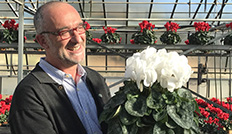 Professional area | Culture factsheet | Feeding | Physical aspects of the growing medium
Professional area | Culture factsheet | Feeding | Physical aspects of the growing medium
The physical fertility of the environment may be regarded as its readiness to supply water and air to the roots.
To feed plants properly, therefore, we have to be able to control, in order:
This is the order in which to approach the choice of a growing medium.


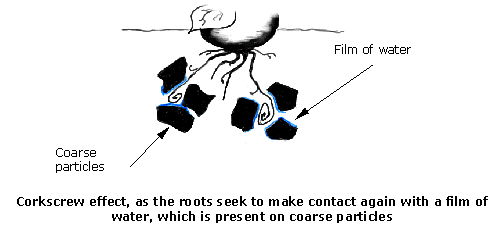
When roots "corkscrew" or "panic", two of their capacities are reduced:
Example :
This is the case of a medium consisting of 70 % bark 15-25 + 30 % peat ; the peat is fine.
If the mix is uneven, the proportion of peat may easily be inadequate.
The roots will then "search" for water, attempting to make permanent contact again with the film of water present on the fibres.
This can lead to trouble.
Since the medium is a drying one, waterings are more frequent.
But these “panicking” roots have only a poor ability to absorb water. They may therefore disappear, either because of drought stress, or by asphyxia.
Their medium, then, has not been constant enough, nor has it protected them.
Typical example of manganese deficiency:
Manganese deficiency is always visible soon after repotting.
Why ? Because during the youngest stages of plant growth, the root system is still little developed, and can only explore a small volume of growing medium or soil.
If the medium is poor in assimilable manganese, the quantities of manganese will be insufficient, and the signs of deficiency appear.
At the same levels of assimilable manganese in the medium, deficiency will not arise in the case of adult plants, thanks to better exploration of the medium by the roots.


That is, the more quickly the medium warms, the more the gases circulate within it, and the more they are dissipated. Carbon dioxide can then be "driven off" by the oxygen partial pressure in the atmosphere within the pot.
Gases, including oxygen and carbon dioxide, are to some extent dissolved in water.
As water is replaced, therefore, it can remove the CO2 load.
The more frequent and regular the waterings can be (this depends on the choice of medium), the greater will this “driving off” effect be.

The choice of medium will also depend on the degree of water mobility desired.
The quicker the turnover of water, the better the roots will perform.

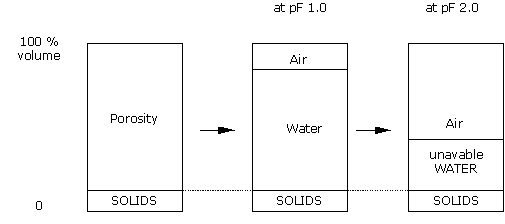
A medium needs to carry out two functions at once:
The contact between roots and medium is an essential element in the control of vigour by means of drought stress.
The more satisfactory the contact between the solids and the root, the better the mechanical protection of the root.
This protection, often provided by fine colloidal material (clayey, or black peat, for example) raises the threshold of the roots’ resistance to drought stress.
Control of vigour is then easier to achieve, because of the "colloïdal" protection of the roots.
Absence of such colloïdal protection for the bulb leads to major growth disorders: leaf curl due to induced boron deficiency, poor flower formation, or blockages of vegetative growth.
Every time heavy material (earth, &c.) is used in the medium, there is a loss of porosity, and the loss of porosity is always to the detriment of air (and not of water).
Now, the more production is required from a cyclamen, the more it has to respire; and this means increased respiration in the roots, as much as elsewhere.

In a given receptacle, a medium will take up a certain volume. This volume is occupied by the solid matter and by the fluids: the liquids and gases.
These fluids are in the "spaces", or pores: their volume, as a percentage of the total, is the porosity.

In a one-litre pot, a blond peat takes up a volume of one litre. Of this volume, only 8% is occupied by solid matter. In a one-litre pot, then, we have a full 920 millilitres of "SPACES"!
This is the advantage of materials with low porosity, for it is in the spaces that the water and air circulate, and these are the two nutrients essential for growth.

Because any loss of porosity (and therefore of spaces) diminishes air first. Now roots must respire in order to be productive, and the better their need for respiration is satisfied, the more they produce.
There can be compaction while repotting, and it may be irreversible.
This phenomenon will be more pronounced the damper the medium.
Take care, then, to firm the medium down less than usual when it is wet.
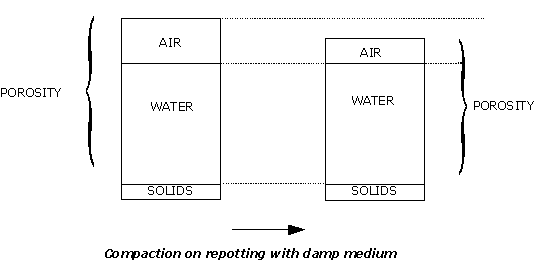
Loss of porosity or of fibrousness is often, at this stage, made up for by root development, which makes it less serious.
What matters to the cyclamen is the volume of water retained in the medium that contains it.
We still need to define this water’s availability to the cyclamen.
Water is only available to the cyclamen when the root is able to exercise suction on this water.
Suction is the process of water transfer across the root membrane, and only occurs when there is a difference of water potential between root and water.
For suction to work, then, the water potential in the medium must always be higher than the water potential in the root.

Example to illustrate the matric force:
Blond peats have a greater fibrousness than black ones, and an even distribution of pore diameters, with a majority of pores being over 30 microns across.
Black peat often retains an equivalent quantity after gravitational draining (water retention capacity 1.0 pF).
Nevertheless, its capillary structure is much finer, and most of its pores have a diameter between 3 and 30 microns, that is, much smaller than blond peat.
The matric forces in the case of black peat are therefore much weaker than for blond peat.
A proportion of the water thus remains unavailable in black peat, for this water is strongly retained in the fine pores.
It should be considered above all as a way of comparing the different mediums.
It will rather be the aim of irrigation to keep the humidity of the medium between two limits :
These values are used as weightings for weighing systems, and as logarithmic values for tensiometers (pF).
Sine the cyclamen’s root system is demanding in terms of air, it is necessary to choose a medium which has the following features:
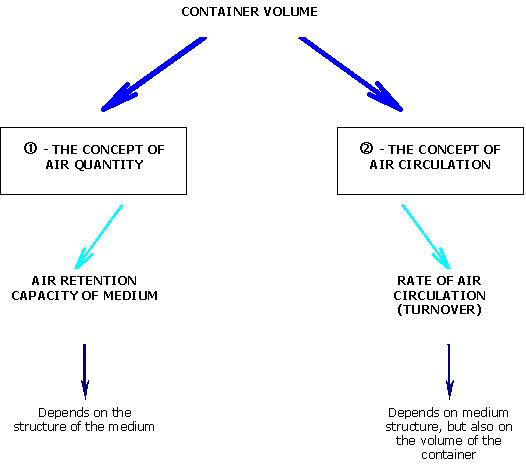
When water leaves one part of the pores, it is replaced, pari passu, by air.
This “air retention” capacity is described by the pF curve.
It is calculated from the following formula:

For each pF, then, there is a corresponding new value of air retention capacity.
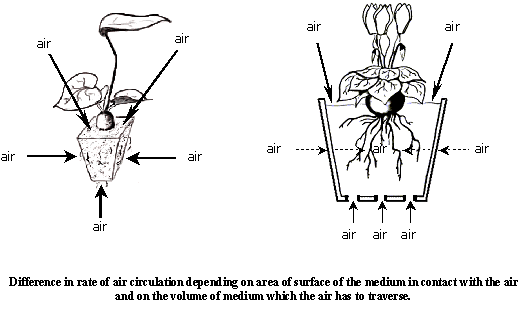
The factors governing the circulation of air within a volume of medium are :
1 - the surface area of contact between the air and the medium;
2 - the volume and the material of the container the air has to "get through".
Example :
In the case of a culture mat for young cyclamen plants, the surface area of contact between air and mat is high.
The roots have very little distance to go to find a satisfactory partial pressure of oxygen.
The medium can in this case have:
This is the situation with conventional mediums composed predominantly of black peat.
By contrast, in 14 cm pots, the surface area in contact with the air is less.
The proportion of air within the pot must therefore be increased.
The same black peat, when used in a pot, causes suffocation, because the availability of air throughout the pot is insufficient.
More aerated materials must therefore be used:
The greater the volume of the container, the better must be the medium’s capacity to become aerated again after watering.
To be productive, the roots must respire.
But they also need to have sufficient warmth.
If not enough heat is provided to the roots, then the cyclamen’s respiration coefficient goes down, with poorer production as a result.
Now the faster the ambient air of the glasshouse circulates through the medium, the more the medium is warmed, by the heat which this air provides.
On the other hand, when the heat provided by the circulation of air is excessive, then the medium should be selected for its capacity to cool, not least because great care must be taken to ensure that there is still a sufficient quantity of "unavailable water".

Above a pF of 2.0, it is generally considered that water is not available to the cyclamen, when grown in pots on an organic substrate.
This unavailable water is still obviously beneficial in one way : it provides for dilution of the salinity.
In fact the salinity is often measured in a medium when this is at its water retention capacity.
There is a tendency, especially when managing drought stress, to organise waterings in such a way as almost to reach wilting point.
But real salinity, at pF 2.0, is two to four times higher than as usually measured.
Since cyclamen are particularly sensitive to the effects of excess salinity, care must be taken to choose a medium with an adequate quantity of unavailable water.
In order to manage drought stress, the root must be “protected”
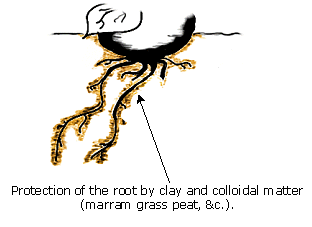
Management of drought stress is important for control of vigour, but also when watering is irregular.
Colloids are negatively charged materials, capable of affinity with the root. The root is thus protected, by clay or organic colloids.
In this way, the wilting point is shifted to pF 2.2 or 2.4.
Without this protection, the management of drought stress is dangerous, and the effective action of some elements (aluminium, iron...) may be reduced.
Certain mediums contain raw materials liable to ferment: fresh bark, non-stabilised fibres, composts, ...
Fermentation :

These materials ferment in the presence of oxygen, producing CO2 (carbon dioxide) in the environment.
This carbon dioxide, if not driven off regularly, suffocates the roots, which are unable to respire enough.
The roots are asphyxiated, not drowned by excess water but saturated with carbon dioxide.
And contrary to general opinion, plants grown on mediums liable to fermentation suffer first from lack of oxygen, even before nitrate deficiency.
That is why it is important to choose the most stable medium possible!
Rule n° 1: Always use up the full RUR (Readily Usable Reserve) before starting to water.
(Quantity of water measured between pF 1.0 and pF 1.7).
The roots are then sure of enough oxygen for their needs, and can take another temporary drowning.
Rule n° 2: Avoid excessive drying-out of surface layers, to the detriment of the medium’s physical qualities: give less watering at a time, so that the medium is dampened again only to a limited depth within the pot. This is the watering pattern to use for the first weeks after repotting, to encourage the formation of the main roots.
Rule n° 3: Periodically ensure a good wash through, so as to replace the atmosphere within the medium: the “driving off” effect.
Rule n° 4: Avoid decreasing humidity below the RUR (Readily Usable Reserve) if the maximum vigour is desired, i.e. large leaves and a voluminous habit, with fewer flowers.
Rule n° 5: Only water when much of the usable reserve (Water availability between pF 1.0 and pF 2.0) has been used to manage drought stress, and keep a leaf/flower balance. Do not keep too much on the dry side, to avoid precocious flowering and poor bulb function.
Rule n° 6: Regulate salinity in accordance with quantity of unavailable water (Porosity - Water availability), especially in summer. Keep conductivity levels fairly low, to avoid encouraging cryptogam attack.
Rule n° 7: Think in terms of “irregular” waterings, rather than regular amounts and cycles in the inter-seasonal periods, so as to re-stimulate in particular the assimilation of elements such as calcium and magnesium.
Rule n° 8: "Ponding" is not a good practice on cyclamen. It leads to unbalanced growth, floppy habit, and risks of disease.
2565, rue de Montourey
83600 Fréjus - France
International telephone : +33 (0)4 94 19 73 04
Switchboard : + 33 (0)4 94 19 73 00
Fax : +33 (0)4 94 19 73 19

